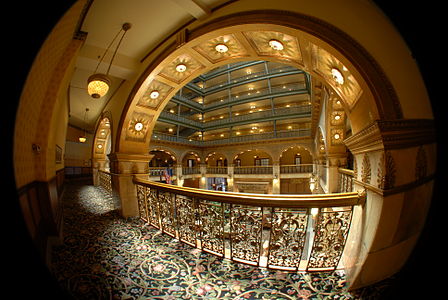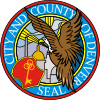Brown Palace Hotel (Denver)
The Brown Palace Hotel and Spa, Autograph Collection | |
 The Brown Palace Hotel, with the 1959 annex tower visible behind it on the left. | |
| Location | 17th St. and Tremont Pl., Denver, Colorado |
|---|---|
| Coordinates | 39°44′39″N 104°59′14″W / 39.74417°N 104.98722°W |
| Area | 9.5 acres (3.8 ha) |
| Built | 1892 |
| Architect | Frank Edbrooke Giddes & Seerie, builder |
| Architectural style | Italian Renaissance Revival |
| NRHP reference No. | 70000157[1] |
| CSRHP No. | 5DV.110 |
| Added to NRHP | April 28, 1970 |
The Brown Palace Hotel and Spa, Autograph Collection is a historic hotel in Denver, Colorado, United States. It is the second-longest operating hotel in Denver and is one of the first atrium-style hotels ever built.[2] It is now operated by Quorum Hotels and Resorts, and joined Marriott's Autograph Collection Hotels in 2012. The hotel is located at 321 17th Street between 17th Street, Broadway and Tremont Place in downtown Denver behind the Republic Plaza. The main entrance door is on Tremont Place.
History
The hotel was built in 1892 of sandstone and red granite,[3] one year later than the Oxford Hotel. It was named for its original owner, Henry C. Brown, who had originally homesteaded the Capitol Hill area,[4] and was designed with its distinctive triangular shape by architect Frank Edbrooke, who also designed the Oxford Hotel. The interior and the exterior of the building are considered to be the "finest extant example" of Edbrooke's work.[5]
Built with an iron and steel frame covered with cement and sandstone, the building was "one of America's first fireproof structures, according to a May 21, 1892 cover story in Scientific American." Upon its completion it was Denver's tallest building.[6]
In the early 1930’s Colorado muralist Allen Tupper True began discussing the possibility of creating two murals for the hotel with then owner Denver financier Charles Boettcher[7] and after some delay the two works, Stage Coach and Airplane Travel were unveiled in the hotel’s lobby in 1937.[8]
In 1935, as a celebration of the Repeal of Prohibition in the United States, Denver architect Alan Fisher designed 'The Ship's Tavern" room.[9]
Annex
The 22-story, 231-room tower directly across Tremont Place was built as a new wing of the hotel in 1959, known as the Brown Palace West.[10] For many years it operated as a budget wing of the hotel, until the Brown Palace's owners branded the guest rooms in the annex as a Comfort Inn in 1988, and then as a Holiday Inn Express in December 2014.[11] Crow Holdings, Inc owns both The Brown Palace and the tower,[12] and the lower levels of the tower are shared with the Brown Palace, including the Grand Ballroom and executive offices. The tower is connected to the main building by a skybridge over Tremont Place and a service tunnel running under the street.
Background
Past guests include the "Unsinkable" Molly Brown (she stayed at the hotel only a week after the Titanic disaster), infamous Denver crime boss Jefferson "Soapy" Smith, Dr. Sun Yat Sen (just before becoming the president of the new Republic of China), Queen Marie of Romania, and The Beatles. Presidential guests include Theodore Roosevelt, William Taft, Warren Harding, Harry S. Truman, Dwight D. Eisenhower and Bill Clinton.
The hotel was the site of the high profile 1911 murders in which Frank Henwood shot and killed Sylvester Louis "Tony" von Phul, and accidentally killed an innocent bystander, George Copeland, in the hotel's "Marble Bar." Henwood and von Phul were rivals for (or shared) the affections of Denver socialite Isabel Springer, the wife of wealthy Denver businessman and political candidate John W. Springer. The murders culminated in a series of very public trials.[13]
Gallery
- Brown Palace Hotel
-
The Brown Palace atrium stained glass ceiling
-
Historic balconies and interior architecture in atrium of The Brown Palace
-
Historic staircase detail and interior design in The Brown Palace
-
Brown Palace outer facade
-
Standing on the flatiron shaped corner of The Brown Palace, looking up it's easy to see how dramatically angled the building is.
-
The Brown Palace and its then-new annex tower, seen in 1964
-
Brown Palace Interior and Atrium
References
- ^ "National Register Information System". National Register of Historic Places. National Park Service. July 9, 2010.
- ^ Richardson, Bruce (2006). The Great Tea Rooms of America. Benjamin Press. ISBN 0-9663478-6-2.
- ^ Fielder, John (2002). John Fielder's Best of Colorado. Big Earth Publishing. p. 21. Retrieved 4 November 2013.
- ^ Noel, ThomasJ., Buildings of Colorado, Oxford University Press, New York 1997 p.53
- ^ Morris, Langdon, Denver Landmarks, photos by Melvyn E. Schieltz, Charles W. Cleworth Publisher, Denver, Colorado 1979 pp. 310-311
- ^ Noel, ThomasJ., Buildings of Colorado, Oxford University Press, New York 1997 p. 53
- ^ http://jeffco.us/boettcher-mansion/history/charles-boettcher/
- ^ True, Jere and Victoria Tupper Kirby, Allen Tupper True: An American Artist, Canyon Leap, San Francisco in association with the Museum of the Rockies, Montana State University, Bozeman, Montana pp.374-380
- ^ Noel, ThomasJ., Buildings of Colorado, Oxford University Press, New York 1997 p. 54
- ^ http://www.prweb.com/releases/2015/07/prweb12850182.htm
- ^ http://www.bizjournals.com/denver/news/2014/12/18/brown-palace-annex-becomes-a-holiday-inn-express.html
- ^ http://www.pinkardcc.com/project/holiday-inn-express-and-suites
- ^ Kreck, Dick, ‘’Murder at the Brown Palace: A True Story of Seduction & Betrayal’’, Fulcrum Publishing, Golden, Colorado, 2003











